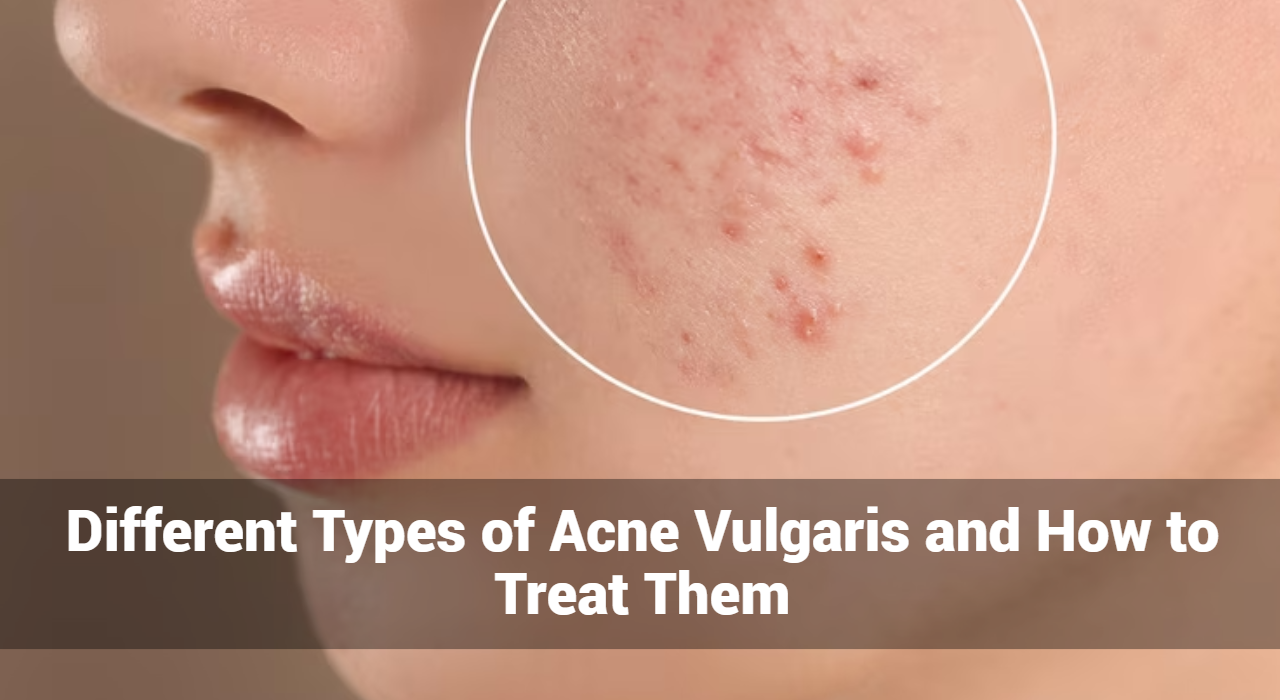Different Types of Acne Vulgaris and How to Treat Them

Acne vulgaris, commonly known as acne, is one of the most prevalent skin conditions affecting people worldwide, particularly adolescents. Characterized by various types of pimples, acne can be a persistent and sometimes severe issue. Understanding the different types of acne vulgaris and the most effective treatment options is essential for managing this condition and achieving clearer skin. This comprehensive guide explores the types of acne vulgaris and provides detailed information on how to treat each type.
What is Acne Vulgaris?
Acne vulgaris is a chronic skin conditions involving the sebaceous (oil) glands at the base of hair follicles. It typically occurs during puberty when hormonal changes trigger the sebaceous glands to produce more oil. This excess oil, combined with dead skin cells, clogs hair follicles, leading to various forms of acne.
What Are The Causes of Acne Vulgaris?
Several factors contribute to the development of acne vulgaris:
- Hormonal Changes: Increased androgen levels during puberty, menstruation, or pregnancy can stimulate the sebaceous glands.
- Genetics: A family history of acne can increase the likelihood of developing the condition.
- Bacteria: Propionibacterium acnes (P. acnes) bacteria on the skin can infect clogged pores.
- Diet: Certain foods, particularly those high in sugars and dairy, can exacerbate acne.
- Stress: Stress can trigger hormonal changes that worsen acne.
- Medications: Some drugs, including corticosteroids and androgens, can contribute to acne development.
Acne vulgaris can manifest in various forms, each requiring specific treatment approaches. Here are the main types of acne:
1. Comedonal Acne
Comedonal acne is characterized by non-inflammatory lesions known as comedones. These include:
- Whiteheads (Closed Comedones): Small, flesh-colored or white bumps caused by clogged hair follicles. They remain beneath the skin’s surface.
- Blackheads (Open Comedones): Dark, open pores filled with excess oil and dead skin cells. The dark color is due to the oxidation of melanin, not dirt.
Treatment for Comedonal Acne
- Topical Retinoids: Adapalene, tretinoin, and tazarotene help to unclog pores and promote skin cell turnover.
- Salicylic Acid: This beta-hydroxy acid exfoliates the skin and helps keep pores clear.
- Benzoyl Peroxide: Reduces bacteria and excess oil.
2. Papulopustular Acne
Papulopustular acne is characterized by inflamed lesions:
- Papules: Small, red, raised bumps that can be tender to the touch.
- Pustules: Similar to papules but filled with pus, giving them a white or yellow center.
Treatment for Papulopustular Acne
- Topical Antibiotics: Clindamycin and erythromycin reduce bacteria and inflammation.
- Benzoyl Peroxide: Often used in combination with topical antibiotics for enhanced effectiveness.
- Topical Retinoids: Promote cell turnover and prevent new lesions.
- Oral Antibiotics: Doxycycline, minocycline, and tetracycline can be prescribed for moderate to severe cases.
3. Nodulocystic Acne
Nodulocystic acne involves deep, inflamed, and painful lesions:
- Nodules: Large, solid, painful lumps beneath the skin.
- Cysts: Deep, pus-filled lesions that can cause scarring.
Treatment for Nodulocystic Acne
- Oral Antibiotics: Doxycycline and minocycline are commonly prescribed.
- Oral Isotretinoin (Accutane): A potent drug for severe cases, it reduces oil production and inflammation.
- Intralesional Corticosteroid Injections: Directly injected into nodules and cysts to reduce inflammation and pain.
- Hormonal Treatments: Birth control pills or anti-androgens like spironolactone for women.
4. Acne Mechanica
Acne mechanica is caused by friction, pressure, or heat on the skin:
- Symptoms: Small bumps, redness, and irritation in areas exposed to friction or pressure (e.g., from helmets, tight clothing, or sports equipment).
Treatment for Acne Mechanica
- Protective Gear: Use padded, moisture-wicking clothing and equipment.
- Skincare Routine: Gentle cleansing and non-comedogenic moisturizers.
- Topical Treatments: Benzoyl peroxide or salicylic acid to prevent clogged pores.
5. Acne Conglobata
Acne conglobata is a severe form of acne involving interconnected nodules and abscesses:
- Symptoms: Deep, interconnected nodules and cysts with extensive inflammation, often leading to scarring.
Treatment for Acne Conglobata
- Oral Isotretinoin: The most effective treatment for severe cases.
- Oral Antibiotics: To reduce bacterial infection and inflammation.
- Corticosteroids: Systemic or intralesional to reduce severe inflammation.
- Surgical Intervention: Drainage or excision of large cysts.
General Acne Vulgaris Treatment Approaches
Topical Treatments
- Retinoids: Promote cell turnover and prevent clogged pores.
- Antibiotics: Reduce bacteria and inflammation.
- Benzoyl Peroxide: Kills bacteria and reduces oil production.
- Salicylic Acid: Exfoliates and keeps pores clear.
Oral Medications
- Antibiotics: For moderate to severe acne, reducing bacteria and inflammation.
- Hormonal Treatments: Birth control pills or anti-androgens for hormonal acne in women.
- Isotretinoin: For severe, treatment-resistant acne.
Lifestyle and Home Remedies for Acne Vulgaris
Managing acne vulgaris effectively often requires a comprehensive approach that includes not only medical treatments but also lifestyle modifications and home remedies. These strategies can help reduce the frequency and severity of acne flare-ups and support overall skin health. Here are some practical tips and home remedies to incorporate into your daily routine.
Analyze Skin Diseases
Use our AI chatbot to determine your skin condition
Skincare Routine
- Gentle Cleansing
- Use a Mild Cleanser: Choose a gentle, non-comedogenic cleanser to wash your face twice daily—morning and evening. Avoid harsh soaps or scrubbing, which can irritate the skin and worsen acne.
- Warm Water: Use lukewarm water for cleansing, as hot water can strip the skin of its natural oils and cold water may not effectively remove dirt and oil.
- Moisturizing
- Non-Comedogenic Moisturizers: Opt for oil-free, non-comedogenic moisturizers to keep your skin hydrated without clogging pores. Even oily skin needs moisture to prevent the skin from overproducing oil.
- Sun Protection
- Sunscreen: Use a broad-spectrum sunscreen with an SPF of at least 30. Choose a non-comedogenic formula to avoid clogging pores. Sun exposure can exacerbate acne and cause hyperpigmentation.
- Avoid Touching Your Face
- Hands Off: Refrain from touching your face frequently, as this can transfer oils, dirt, and bacteria to your skin, leading to clogged pores and acne.
- Hair Care
- Clean Hair: Keep your hair clean and off your face. Oils and hair products can contribute to acne along the hairline and forehead.
Diet and Nutrition
- Balanced Diet
- Whole Foods: Focus on a diet rich in fruits, vegetables, whole grains, and lean proteins. These foods provide essential nutrients that support skin health.
- Healthy Fats: Include omega-3 fatty acids found in fish, flaxseeds, and walnuts, which have anti-inflammatory properties.
- Avoid High-Glycemic Foods
- Limit Sugary Foods: High-glycemic foods such as sugary snacks, white bread, and sweetened beverages can spike blood sugar levels, potentially leading to increased oil production and acne.
- Dairy Moderation
- Monitor Dairy Intake: Some studies suggest that dairy products, particularly skim milk, may be linked to acne. Consider reducing dairy consumption to see if it improves your skin.
- Stay Hydrated
- Drink Water: Adequate hydration is essential for maintaining skin health. Aim to drink at least eight glasses of water a day to keep your skin hydrated and help flush out toxins.
Stress Management
- Relaxation Techniques
- Mindfulness and Meditation: Practice mindfulness, meditation, or deep-breathing exercises to reduce stress, which can trigger or worsen acne.
- Yoga and Exercise: Regular physical activity can help reduce stress and improve overall health. Exercise increases blood flow, which can help nourish skin cells and keep them healthy.
- Adequate Sleep
- Sleep Hygiene: Aim for 7-9 hours of quality sleep each night. Lack of sleep can increase stress hormones, leading to more acne breakouts.
Home Remedies
- Tea Tree Oil
- Antibacterial Properties: Tea tree oil has natural antibacterial properties that can help reduce acne-causing bacteria. Dilute tea tree oil with a carrier oil (such as jojoba or coconut oil) and apply it to affected areas.
- Aloe Vera
- Soothing Effect: Aloe vera has anti-inflammatory and healing properties. Apply pure aloe vera gel directly to the skin to reduce redness and inflammation.
- Honey and Cinnamon Mask
- Antimicrobial Properties: Both honey and cinnamon have antimicrobial properties. A mask made of honey and cinnamon can help reduce acne and soothe the skin. Mix 2 tablespoons of honey with 1 teaspoon of cinnamon and apply to the face for 10-15 minutes before rinsing off.
- Green Tea
- Antioxidant Properties: Green tea has antioxidants that can help fight inflammation and reduce sebum production. Apply cooled green tea bags to affected areas or use green tea extract in your skincare routine.
- Apple Cider Vinegar
- Natural Astringent: Apple cider vinegar can help balance the skin’s pH and has antibacterial properties. Dilute one part apple cider vinegar with three parts water and apply with a cotton ball to the skin. Use with caution, as it can cause irritation in some individuals.
Additional Tips
- Avoid Picking or Popping Pimples
- Minimize Scarring: Picking or popping pimples can lead to scarring and further infection. Use treatments to manage acne and allow it to heal naturally.
- Clean Pillowcases and Towels
- Hygiene: Change pillowcases and towels regularly to avoid the accumulation of oil, bacteria, and dead skin cells that can exacerbate acne.
- Stay Consistent
- Routine: Stick to your skincare and treatment routine consistently, as acne treatments often take several weeks to show significant results.
Professional Treatments
- Chemical Peels: Exfoliate the skin and improve the appearance of acne and acne scars.
- Laser and Light Therapy: Reduce bacteria and inflammation.
- Extraction: Manual removal of comedones by consultant a dermatologist.
Conclusion
Acne vulgaris can manifest in various forms, each requiring specific treatment strategies. By understanding the different types of acne and their respective treatments, individuals can better manage their condition and achieve clearer skin. Consulting a dermatologist for a personalized treatment plan is crucial for effectively addressing acne vulgaris and minimizing its impact on one’s quality of life. With the right approach, acne can be managed, leading to improved skin health and self-confidence.





